As a woman who is 5 foot 7 inches tall, I realize I am at an advantage when it comes to fitting most motorcycles. That said, I have ridden plenty of motorcycles where I can only reach the ground on tiptoes. I’ve only tipped a bike over once learning valuable lessons in the process that I’m about to share to with you.
"... if you desire to ride a taller bike ... a boost in confidence is what you need."
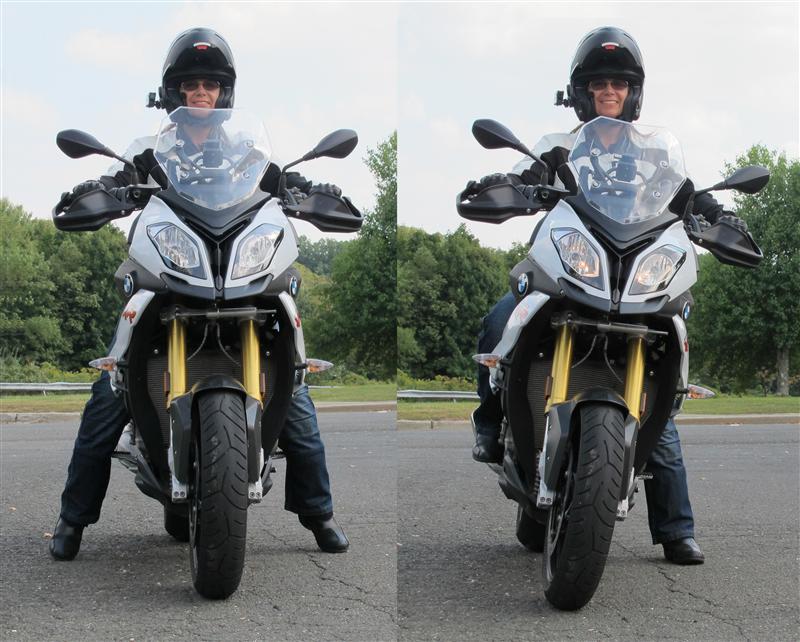
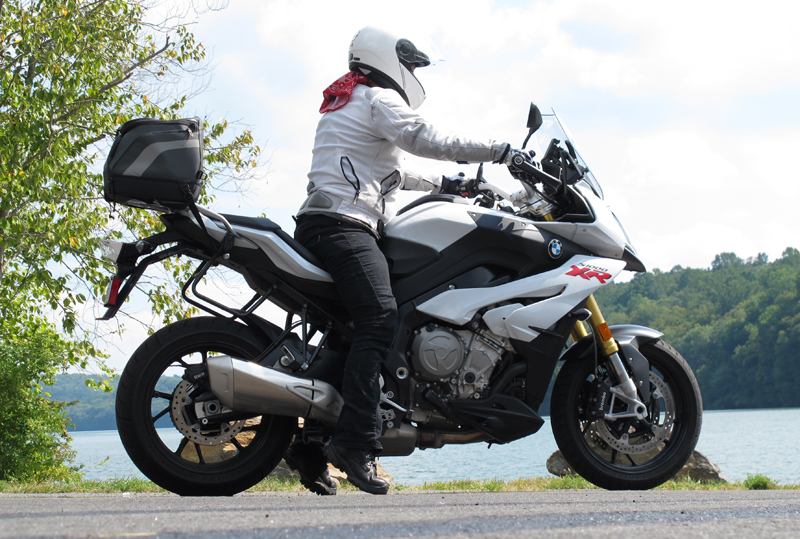
In my job as an MSF RiderCoach and as a journalist in the motorcycle industry, I often hear women say that there aren’t enough motorcycles out there to fit them so selection is limited. If you are a proficient rider, you are not limited by the motorcycles that fill your local dealership’s showroom. You are limited by your own self-confidence.
I’m going to show you how to ride a tall motorcycle without lowering the suspension or using a reduced reach seat.
So if you desire to ride a taller bike but physically can only get your tiptoes on the ground, then a boost in confidence is what you need. The following five tips will help.
1. Practice and become proficient on a small bike, one where you can put both feet flat on the ground.
Practice accelerating quickly from a stop. Practice starting out on a hill. Practice quick stops and swerves. Practice backing up out of a parking space by walking the bike while standing next to it. Practice stopping by placing only your left foot on the ground. Ride a lot and experience all kinds of different scenarios on a bike that you can handle easily.
Once you are really good and have plenty of real life experience, go shopping for a bigger bike. If you’ve got the skills, you don’t need to put both feet on the ground anymore. I’ve seen some incredibly skilled female motorcyclists ride bikes where they can’t put any part of their feet on the ground! Believe me, it is possible, and we all can do it. Here’s a story we did years ago on a 4-foot-11 Jennifer Hooper who is one of them.
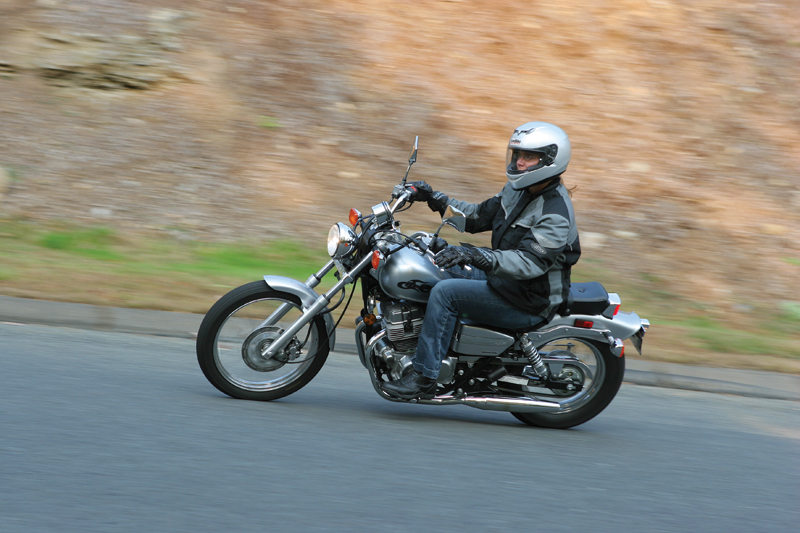
2. Have a Plan Before You Put Your Feet Down
Scope out the parking situation. Before I even turn into a parking lot, I am scouting it out for several things: Is it paved? Does it have any grading or slopes where I need to be careful of the direction in which I put the sidestand down? Is there enough room to make a U-turn if I need to? Are there any parking spots where I can pull through so I’m facing forward when I need to leave?
If the lot is not paved, I may just skip it and go somewhere else. If it’s a level surface, or if there are no slopes to contend with, I make sure I park so that the motorcycle won’t roll when parked, but will be easy to get out of when I’m ready to leave.
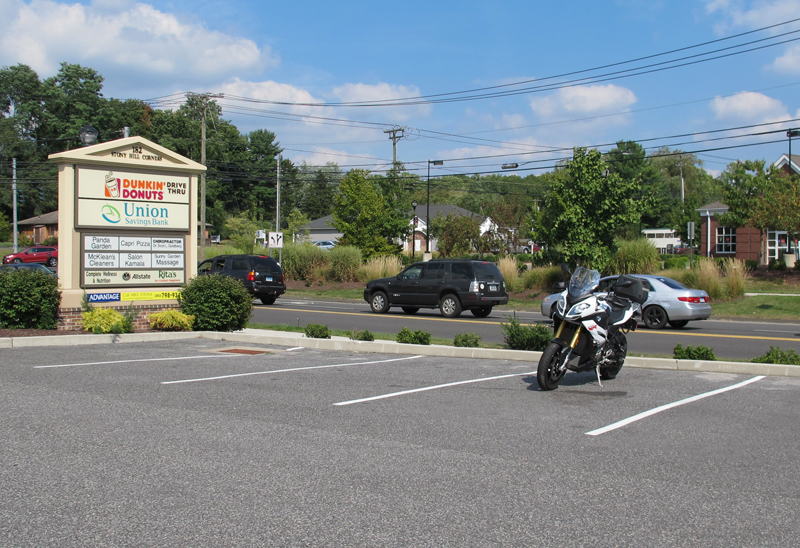
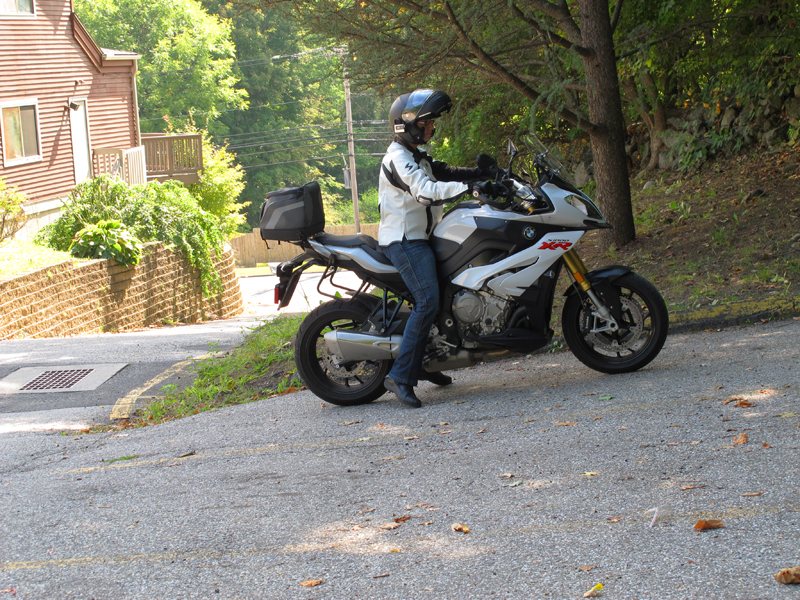
2. Have a Plan Before You Put Your Feet Down
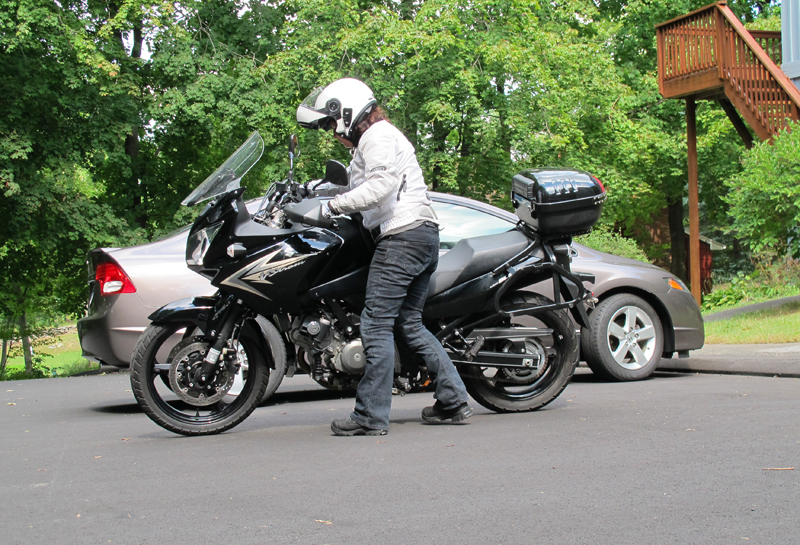
4. Lean left when coming to a stop.
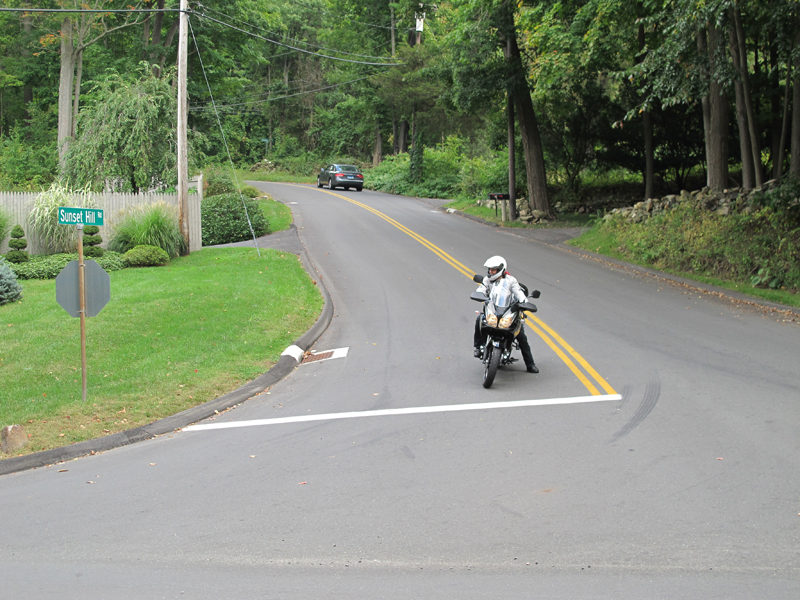
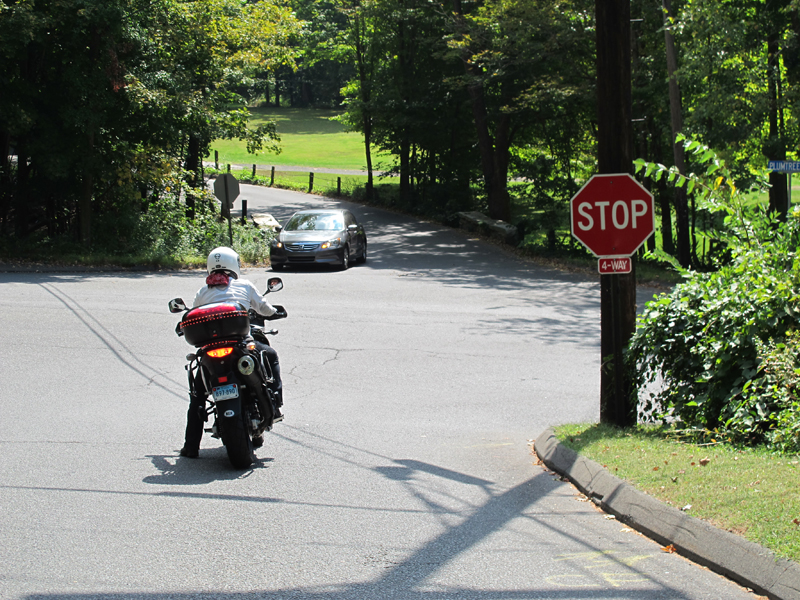
4. Lean left when coming to a stop.
OK, I admit it. I did drop a bike once because I put my foot down and there was no ground there to catch me. This can happen when loading a bike onto a ramp, but it can also happen when you stop in a small “valley.” In other words, the front and rear wheel are on hills, and the ground between drops down. It was nighttime when I did it, and I was in unfamiliar territory, but honestly, I was tired and not being careful enough. You, however, will never make this mistake because you are reading this.
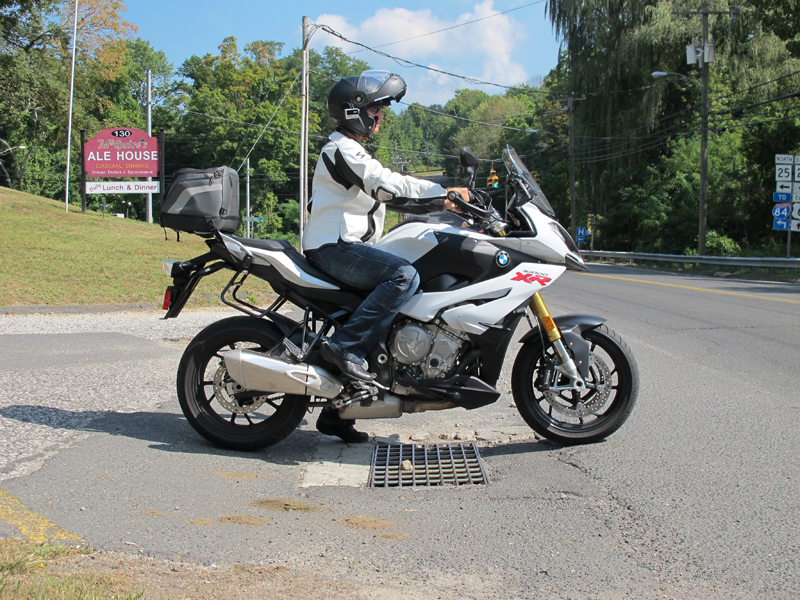
Also be aware of pavement that is sloped. If you need to come to a stop and the ground is sloped, make sure you put a foot down on the “shorter” side of the bike. This is the exception to tip number 4.
If the ground slopes down to the left, you don’t want to lean the bike left because the bike will fall over. Instead, lean it right, so you can get your right foot down to steady the bike when stopping. Make sure you include extra stopping distance in your approach since you’ll have to let off the rear brake with your right foot a little early.
I hope this article inspires some of you to push yourself beyond your personal limitations. You don’t need to have both feet flat on the ground to ride a motorcycle. All motorcycles produced today are engineered to be incredibly balanced machines. Many can almost stand up by themselves. Using the tips of your toes to hold up a motorcycle is all you need besides some skill and confidence. Practice the skills and the confidence will come.

I am 5 feet tall and love this article. As a new rider, the one topic I am struggling with is maneuvering the bike around the garage. I have a two car garage that I have kicked my car out of and I am on a slope so I want to ride straight out of garage. When trying to turn around in the garage, I have huge challenges turning it. I am not strong enough to duck walk it in circles and I haven’t figured out how to keep control when walking beside it. Any advice?
Hi Linda,You ask a great question! There are motorcycle “dollies” out there with castors that will slide under your bike and lift them up slightly so you can then carefully turn the bike around. Do a google search for “Motorcycle Dolly” and you’ll see what I’m talking about. Thanks for the idea for a future product review! I think there are lots of riders who would be interested in something like this, regardless of their riding experience.
Hi! Really good article and I agree completely about confidence. I don’t have much experience so I would need explanation about the left foot. I really don’t understand why you need to put your left foot on the ground at stops? I practice to put my right foot on the ground so I can shift immediately with my left foot if necessary. Which is the reason to put my right feet and change it later. In my opinion it makes the thing more complicated. But there must be a reason I don’t know if all of you do it. Please advise me. Thank you.
Hi Ieva,The reason for putting the left foot down first, is because the right foot is busy using the rear brake. Most bikes are set up with the rear brake pedal on the right side. You want to be in the proper gear (first gear at a stop) before you put your feet down, so that you are ready to take off again, so being able to shift is not an issue at a stop. But controlling that rear brake is very important. And you want to always practice using both brakes to stop so that in an emergency, you have the muscle memory so you use both without even thinking about it.Hope this helps! Good luck.
This article really hit home. At 5 foot 3 inches I have always been vertically challenged. With several decades of riding, the only time I have ever dropped a bike is coming to a stop on uneven ground. I am super careful, but at times it can’t be avoided, unfortunately, and once you are more than a smidge out of perpendicular, it is going over. What I need is longer legs! Great article.
Great article. I recently traded my 750 Honda Shadow Spirit for a 1600 Victory Cross Country. It’s the small things that I have issues with such as parking lots and returning to home to go up a short drive with a slight incline.
I have to disagree heavily with the advice to lean the bike at stop. On the contrary, you want the bike as vertical as possible, for minimal effort in keeping it upright, and keeping it in the center of your balance zone, which is narrower for shorter (and weaker) riders. Learn to move your body over to gently set either foot down and balance the bike upright at stops, not struggle to keep it from getting away from you. How much lean is too much? Everyone has their drop-point. Don’t go there, stay straight up.Also, learn to mount and dismount when it’s vertical, rather than getting on when it’s on the sidestand and then hefting it upright with one foot. Tricky at first but actually far less effort for short riders.Like this article says, yes, plan your parking and stops, learn low-speed maneuvers, walk the bike if you need to—and don’t let anyone tell you that you have to duck-walk or flatfoot or that you can’t ride!
Great tips! Thanks for sharing them.
I am 5 feet 2 inches and am used to a small bike. I have just purchased a Moto Guzzi V7 Classic and have been a bit anxious about taking it out on the road but reading about others in similar situations has boosted my confidence. Thanks!
Nice article. I am 5 feet tall and I’ve ridden lots of different motorcycles. Being vertically challenged has never stopped me. I hope this will help others trying to make their decision. It’s worth pursuing. Thanks for sharing.
Women always need great articles shared by other women riders. Very informative!
At 5 feet 2 inches, tall I can attest to all the good advice in this article. An additional option is to get a custom seat. I ride a factory lowered BMW F 650 GS, which has a stock seat height of 30.3 inches. I have an inseam of 28 inches, but only 26 inches when straddling a seat. I got a custom seat from Corbin that lowered the seat an additional 1.5 inches and also had them narrow the seat so that my “female” thighs fit into the sides of the seat more comfortably. I also wear Daytona Lady Star boots which have a 2.5cm insole rise. Put that all together and riding can be for anyone, no matter their stature.
I agree with article completely. This is exactly what I did. I now ride a Harley-Davidson Ultra Classic. The secret is technique, practice, and confidence. Look on the internet for a video demonstrating how to easily stand up a heavy bike, straightening your wheel, and lifting at the gas tank. It really is about technique.
Check out WRN’s article about how to lift a downed bike.
Great tips! But my issue isn’t just height, it’s the weight of the bike. If I’m not on both feet I don’t think I have the upper body strength to hold up a taller bike. Am I the only one who worries about this?
Great question Sash. I will have our readers answer this over in the Your Questions Answered section on WRN.
Great tips! Riders of all heights should practice the left leg down only technique, since being able to cover the rear brake with your right foot reflexively—and then take off smoothly and unconcernedly—makes uphill starts trivial.
This does work sometimes but when you are 5 feet tall you still can have times when there is not enough ground under your feet.
All good tips. It helps to know how to pick it up when you drop it, too.I ended up selling my Yamaha FJR and using the money to buy a factory lowered BMW 700 GS which l just love. FYI, l’ve been riding for 47 years and am turning 74 this October and still teach MSF classes for my school.
Way to go, Jerry!Yes, it is good to know how to properly pick up a motorcycle. We have step-by-step instructions here for those who would like to see it demonstrated.
One key element to these suggestions/guidelines, is to do it the same way (same foot, same foot, same lean side) at every stop. Get the brain and muscles to remember that “they” must do it every time the same way. Using the inner thigh of the leg as a pusher/holder upper of the bike is also key to small/short riders. They are stronger than your arms, so use them as much as possible. My wife is 5 feet 2 inches and I’m only 5 feet 6 inches, so we know about tall bikes over the last 35 years.
All very good info. There are still the unexpected circumstances that arrive when you find yourself not rolling forward and you have to put your foot down, only when you do there is no ground there to put it on. When this happens the bike is going over whether you like or not. It’s happened three times to me now and it is very frustrating. I’m almost ready to give up and buy something lower. Thanks for the supporting article nonetheless.
This article is amazing. Thank you for all the information here. I’m a 5 feet 1 inch women riding a Royal Enfield Classic 500 and this article surely helped me to understand some things that I probably did wrong once or twice and made me feel a bit insecure. I have practiced a lot in parking spots with your advice, and walking the bike in neutral, this is great! Thank you again and keep on riding! Hugs from Colombia.
I’m a 5 feet 2 inch newbie rider. I was already following the left foot rule on my Yamah FZ-07 but I just picked up my new Triumph Tiger XRX low which is a marvelous bike and I am now able to have two balls of my feet down. The tip on watching the slope is brilliant. The luggage threw my balance off and I had to start with it and now I’m constantly going to watch my grades when stopping and give myself more time to stop in case that right foot is higher.
Very interesting article. I am 5 feet with a mere 24 inch inseam, so even with following your great advice and tips, leaning to the left still leaves my foot too far off the ground to be able to feel safe. A number of my biker friends are my height but have a shorter trunk and longer legs. They are lucky to be able to ride tall bikes. I love my Yamaha Virago 535, which is lucky because that is exactly perfect for me. Thank you for your great articles.
I’m 5 feet 4 inches and currently ride a Triumph Trophy, which clocks in at 770 pounds fueled.The only change to my bike was a low seat option (less padding) so gives me an extra half inch. I’m still tippy-toe on the bike. The five things listed in your story are the rules I live by. So far they’ve taken me riding across Europe on a BMW 1150 and now many countless long trips here in Australia on an even bigger Triumph. I can say it all boils down to taking care of the five things in this story. I regularly have to walk the bike, watch parking spots and think about which foot will go down at the traffic lights every time. I can’t push the bike backwards while seated on it. It hasn’t stopped me traveling anywhere. I started 36 years ago on a little 100cc Yamaha road bike. Being short doesn’t have to be a hindrance. Do these things though and you can ride just about any bike.
I am a disabled male motorcycle rider and have difficulty getting onto motorcycles. I am 5 feet 10 inches tall.Whenever I park my bike I always put it on the center stand so that I can stand on the footpeg and swing my leg over, then I rock the bike off the stand. To get off the bike I put the bike on its sidestand and use that. You would be surprised how strong footpegs and sidestands are. I am not a small bloke and weigh well over 240 lbs and have never had an issue.
Great article for shorter women. I will share this article on Facebook with Women Riders of Louisiana and the Cajun HOG Chapter. I look forward to all the articles. It gives me a sense awareness and validates what I am doing correctly or insights on how to improve my riding experience.As a shorter woman, I recently sold my Harley-Davidson Road King and purchased an Ultra Classic. It’s such a Cadillac of a ride, although the height has made me aware of my lack of height and the weight of the bike. I will apply a few of these tips on parking this bike.
Being 5 feet 8 inches and loving cruisers, I don’t have challenges in the tall bike department, but the tips in this article are great for heavy bikes as well. When I recently got my 2010 V-Rod Muscle, the 666-pound operating weight was a big jump from the 383-pound that my previous bike was. I thought about a lot of the techniques in this article (especially when it comes to parking) and it helps a lot! I hope no one skips over this article because they are not 5 feet 1 inch. There’s something in here for everyone!
Thanks Liv for sharing this insight so other readers are aware.
Good article highlighting that shorter women love to ride! Need to ride! Please, will the motorcycle industry take note. However I have been riding a long time and find paddling backwards into urban parking spaces is very difficult on tippy toes, and when doing this on gravel it’s just a balancing act!
Article is written well for all levels of riders. I do believe bullet number 1 is the most important. Starting out too big will lead to down riders on bikes for both female and male riders. Learning stops and starts on tippy toes or leaning to the left (as well as all other techniques mentioned) are intermediate to advanced level technique. This should not be encouraged during the purchase process for a “new” rider. Practice leads to confidence in riding, then the “tippy toe” ride should follow. Safe miles.
Tricia Szulewski’s suggestions all make great sense. As a sister rider coach, I agree with all of her suggestions.Checking out the lay of the land in advance of deciding which foot to put down really helps. The vast majority of the time, I like to keep my right foot on the rear brake at a stop preferring to put my left foot down first.You actually are a lot more in control and traction by putting one foot down rather than by putting two toes down. There are times when I look at where I am going to have to stop and choose to put my right foot down only if that is the higher side of the road or exit ramp.The other reality I deal with is that the bikes I fall in love with tend to be way taller than the length of my inseam with is 28.5 inches. I own a Kawasaki KLR 650, a Kawasaki KLX250s and a Yamaha 250rR — all dual-sport bikes with seat heights of 35 to 36 inches. I don’t like to lower my suspensions on these bikes as I want the ground clearance they provide in the dirt. So, I have chosen to make my “legs longer” by adding height to the soles of my boots. Over the years, I have come up with a number of strategies to make shifting easy even with the added depth of my soles.
You can see photos here of how Sue modified her boots to make herself “taller” so she could reach the ground on her dual-sport motorcycles. While this is not the first course of action we recommend when trying to manage a taller motorcycle, she and another woman we know have found success in doing this and again, you can read about this at the above and below links. Click here to read our story on recommended ways to lower your motorcycle’s seat height.
Great article. I also had a similar experience years ago that I had bought a DL650 V Strom after riding very low seated cruisers for years. I’m only 5 foot 4, and inevitably struggled. Then I had several training lessons from pros and bought another bike, which is SYM Wolf (a 250cc light naked bike) after a lot of rides (in actually six to seven months). I regained my confidence. And as you said above it was just about the confidence. Now I can easily handle DL while only my both tiptoes touch the ground.
Great article. Everything I’ve ever learned about the subject, with great pictures, too! I’m also an MSF coach, and 5 feet 1-ish, and ride big and tall bikes. I will share this on our school Facebook page. Thanks!
Great article! It was like you were hearing my thoughts when looking for parking. Confidence is found by creating and practicing a routine. At every stop sign, intersection and parking situation, I visual my routine. When the situation changes and for instance I need to put my right foot down, I recite that step by step. “OK, right side’s best, so right foot goes down.” I’m 5 feet 4 inches with short legs and have almost always ridden bikes that are too tall or too heavy for me. I’ve been riding street bikes for more than 30 years now. It wasn’t until I got the Yamaha FJR did I finally have a bike go down at 0 mph. Despite its size and weight, my friend and I did a 6,500 mile 23-day adventure to Nova Scotia, all while towing a Uni-Go trailer. My friend was on a Kawasaki Concourse. Girl power!
Nice article and very helpful info for beginners. Thank you. Experience and confidence is key. I’m 5 feet 2 inches and have sat on so many bikes I feel are too tall and/or too top heavy. Very pleased to say that in my particular experience, thankfully, my instructor taught me all the points you address. And, yes, I did go out and buy my big bike as my first (ever) bike! Dropped her a few times too because I didn’t check out the lay of the land; because I put the wrong foot down; because I didn’t hold her upright enough when walking her back.
City and country were a toss up. Nevada is my real home but I currently live in Dubai for another year. As a rider coach myself these are the same tips I share with my students, being 5 feet 1 inch and riding a BMW 650 GS. Great tips. Great article!
This is a fantastic article Tricia! Thank you. The first quote about needing a boost in confidence really sums it up. That’s the starting point. It’s hard for new riders to grasp that it’s easier to manage by putting just your left foot down both feet. And you don’t need to be flat footed, although it’s nice. Once riders get into the habit (and follow the tips in this article), they’ll realize how it makes things so much easier when handling any bike—including those they’ve ruled out because they were considered too tall.